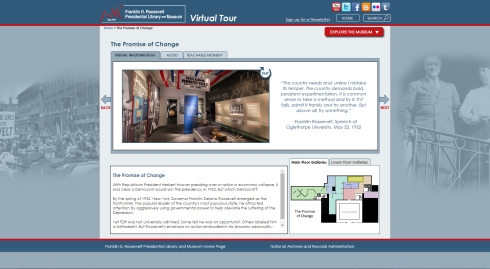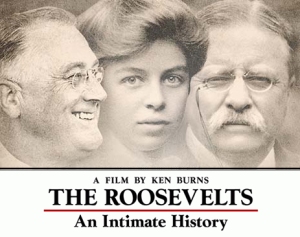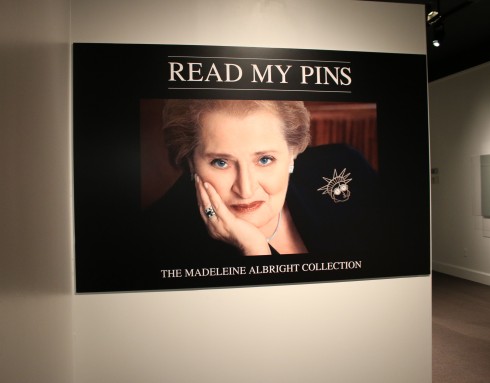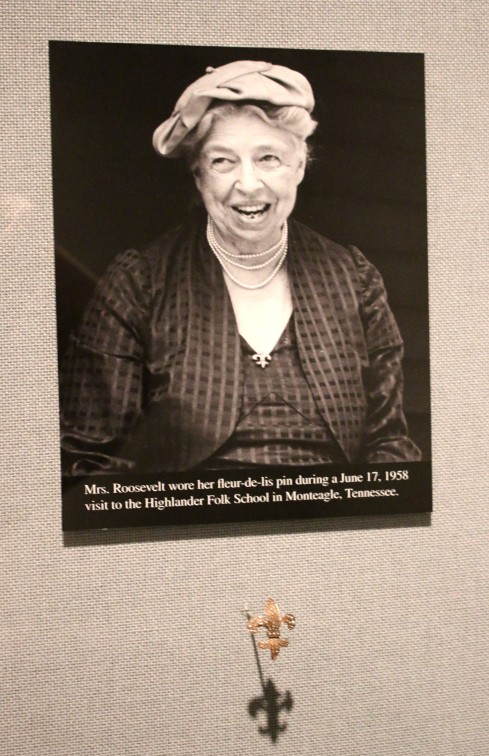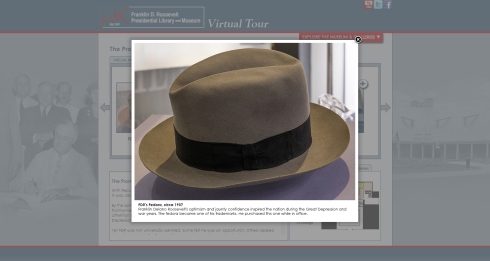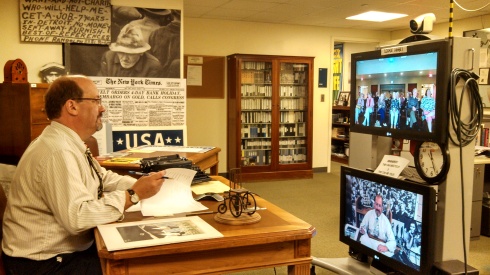It’s been a great 5 years for In Roosevelt History, but it is time for a fresh new look and feel. Besides an update, we are also moving our new blog to http://fdr.blogs.archives.gov/. So, be on the look out for new content starting Sunday, April 12th on our new blog Forward With Roosevelt. See you all there!
On January 30, the Roosevelt Library unveiled its latest initiative to harness new media technologies to reach new audiences– an online, interactive Virtual Tour of the Museum’s 12,000 square foot permanent exhibition.
The Virtual Tour lets visitors from all over the world experience the Museum and access additional educational materials. Funded by a generous grant from the Newman’s Own Foundation, it vastly increases the Museum’s reach, serving as an access option for people who cannot otherwise benefit from the Museum due to physical, sensory, economic, or intellectual barriers. Bringing the Museum online allows the Library to provide a more welcoming, inclusive, and meaningful experience to audiences from all walks of life.
The Virtual Tour was developed by Library staff working with the Dynology Corporation of Vienna, Virginia. Museum Technician Katherine Sardino guided the Library team on this innovative project. “In recent years, museums have started to embrace virtual tours,” Sardino notes. “Art museums have been more assertive than history museums in adopting this new interpretive tool. But few have as many features as our new tour.”
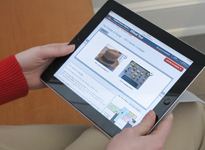 The new Tour is a comprehensive, self-guided interactive experience that gives anyone with a desktop, laptop, tablet, or mobile device the ability to explore the permanent exhibition. Users can zoom-in and navigate through 360 degree panoramic views of the galleries. They can view select documents, artifacts, photographs, and graphics and examine the exhibition’s ten “Confront the Issue” special topics (which range from “What Caused the Great Depression” to “FDR and Japanese American Internment”). Users can also access other exciting features from the exhibition, including audio of Fireside Chats and Eleanor Roosevelt radio addresses, a program that browses the contents of FDR’s Oval Office desk, and footage from Mrs. Roosevelt’s television appearances during the 1950s and 1960s.
The new Tour is a comprehensive, self-guided interactive experience that gives anyone with a desktop, laptop, tablet, or mobile device the ability to explore the permanent exhibition. Users can zoom-in and navigate through 360 degree panoramic views of the galleries. They can view select documents, artifacts, photographs, and graphics and examine the exhibition’s ten “Confront the Issue” special topics (which range from “What Caused the Great Depression” to “FDR and Japanese American Internment”). Users can also access other exciting features from the exhibition, including audio of Fireside Chats and Eleanor Roosevelt radio addresses, a program that browses the contents of FDR’s Oval Office desk, and footage from Mrs. Roosevelt’s television appearances during the 1950s and 1960s.
The Virtual Tour also features special educational resources produced by the Library’s Education staff, These include a series of web-exclusive “Teachable Moment:” films. These short films provide overviews of important topics from the Roosevelt era, including Social Security and FDR’s Four Freedoms.
Early social media responses to the Virtual Tour have been enthusiastic. A Facebook user enthused, “Excellent online tour. It whets my appetite to return to the Library, which I visited in 2007.” Another wrote, “This is the perfect way to celebrate the life of such a great man and American spirit, by making his life and work even more accessible.” A Twitter fan noted “New virtual tour of museum @FDRLibrary if Hyde Park NY is not on your travel itinerary (though it should be)” Another said simply: “Next best thing to being there”.
Experience the new Virtual Tour yourself: http://www.fdrlibraryvirtualtour.org
Since Ken Burns’ documentary The Roosevelts: An Intimate History aired on PBS during the week of September 14th, the Franklin D. Roosevelt Presidential Library and Museum has experienced an overwhelming upsurge in interest. Museum visitation is up 25%, and the parking lots are overflowing. Visits to the Library’s website jumped 650% during the week that the film aired. Research requests to the Library’s archives and museum doubled, and sales in the New Deal Store increased 39%.
All of the Library’s social media platforms also saw a huge increase in views. The real standouts were our blog and Flickr page. The number of total views for September 2014 for our In Roosevelt History blog increased 117% over the same month last year. The total views for the Library’s Flickr page for September 2014 was 126,105, a 114% increase from September 2013.
We appreciate everyone who has called, written, or visited the Library, and gone to our website and social media to learn more. When FDR created this presidential Library and gave it to the American people, his hope was that people would visit here and learn from the past so they would be able to create a better future for themselves. That mission of discovery and learning is something we take very seriously here, and we try very hard to fulfill that mission by welcoming visitors from all over the world, offering interesting and innovative public programs and providing innovative educational programs.
Want to do your part to keep the Roosevelt Legacy alive? Support the work of the Roosevelt Library by becoming a member today!!

 On September 14, 2014, PBS stations across the country will begin broadcasting the latest film by Ken Burns, The Roosevelts: An Intimate History. This seven-part documentary weaves together the stories of Theodore, Franklin and Eleanor Roosevelt, three members of one of the most prominent and influential families in American politics.
On September 14, 2014, PBS stations across the country will begin broadcasting the latest film by Ken Burns, The Roosevelts: An Intimate History. This seven-part documentary weaves together the stories of Theodore, Franklin and Eleanor Roosevelt, three members of one of the most prominent and influential families in American politics.
The 14-hour series marks the first time their individual stories have been woven into a single narrative, and it is the first time that PBS has premiered such a film in two-hour blocks over seven consecutive nights.
The Franklin D. Roosevelt Presidential Library and Museum in Hyde Park, New York, assisted Burns’ Florentine Films production team throughout the entire process of making the film. The first visit to the Roosevelt Library by Florentine staff happened in May 2009. Over the course of the next five years, the Roosevelt staff helped the crew in researching, understanding, and filming the Library’s archival and museum collections. The Library staff also assisted renowned Roosevelt biographer Geoffrey C. Ward as he honed the film’s script and wrote the accompanying book. The entire process was collaborative and collegial, with the Florentine team sharing the digital by-products of their labors and the Library offering suggestions for documents, photographs, and objects to use in the film. And it can be said that the Florentine crew survived the Library’s three and half year renovation right along with the Library staff. During the film project, the Florentine team worked in the pre-renovation research room in 2009, moved right along with the staff to the temporary research room in the Library’s Wallace Visitor Center in 2010, and moved back to the renovated Library in 2013. Burns’ team also worked closely with the National Park Service, which operates the Home of FDR National Historic Site on the same grounds as the Library.
Ken Burns made a special visit to Hyde Park on June 12, 2014, to preview the excerpts from the film to a packed audience in the Wallace Visitor Center. Afterwards, Ken Burns and Geoff Ward hosted a special lunch where they personally thanked the staffs of the Roosevelt Library and the National Park Service for their assistance in creating The Roosevelts: An Intimate History – an epic documentary that will bring the world of the Roosevelts to a whole new generation.
The Library lost a dear friend and favorite researcher last week. Joseph Persico, best-selling author, historian and speechwriter for Gov. Nelson Rockefeller died at the age of 84. Persico wrote 12 books, including biographies of Rockefeller, Edward R. Murrow, CIA director William Casey and Franklin Roosevelt. He was selected to write the words etched in granite at the National World War II Memorial: “Here we mark the price of freedom.”
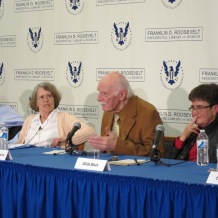 Of Persico’s writing career, Eric Sevaried described his Edward R. Murrow: An American Original as “the definitive” biography of the broadcast pioneer. The New York Times said of Persico’s The Imperial Rockefeller, “No one has written a book like this about Nelson Rockefeller before.” His Nuremberg: Infamy on Trial was described by the broadcast journalist, Howard K. Smith, as “Simply the best account of the trial.” This book was adapted by Turner Network Television as a miniseries that won two Emmy awards. Persico was the collaborator on former Secretary of State Colin Powell’s autobiography, My American Journey which remained twenty weeks on the New York Times best seller list.
Of Persico’s writing career, Eric Sevaried described his Edward R. Murrow: An American Original as “the definitive” biography of the broadcast pioneer. The New York Times said of Persico’s The Imperial Rockefeller, “No one has written a book like this about Nelson Rockefeller before.” His Nuremberg: Infamy on Trial was described by the broadcast journalist, Howard K. Smith, as “Simply the best account of the trial.” This book was adapted by Turner Network Television as a miniseries that won two Emmy awards. Persico was the collaborator on former Secretary of State Colin Powell’s autobiography, My American Journey which remained twenty weeks on the New York Times best seller list.
His Roosevelt’s Secret War: FDR and World War II Espionage also reached the best seller list and was chosen as one of the notable books of the year. His, Eleventh Month, Eleventh Day, Eleventh Hour, on Armistice Day, World War I, has been described by historian, Richard Norton Smith as, “The single finest work I have read on the Great War.” The Washington Post’s Book World said of his Franklin and Lucy: President Roosevelt, Mrs. Rutherfurd, “Persico… understands that Lucy Mercer helped FDR awaken his capacity for love and compassion, and thus helped him become the man to whom the nation will be eternally in debt.” “Roosevelt’s Centurions,” a detailed history of his World War II commanders — a 650-page volume published last year, was his final published book and his most ambitious.
His articles have been published in American Heritage Magazine and the Military History Quarterly. He was a frequent reviewer for the New York Times Book Review and the Washington Post Book World and was a commentator on several PBS and History Channel documentaries.
Joe Persico was a wonderful scholar and a true gentleman. He was generous with his time and his expertise, appearing at five of our annual Roosevelt Reading Festivals. His program here at the Library in December 2001 on the 60th anniversary of Pearl Harbor–coming just weeks after the 9/11 attacks–was one of the most memorable and meaningful events in the Library’s long history.
He will be greatly missed by his friends in Hyde Park.
Starting on August 9th, Museum visitors will be able to experience a new traveling exhibition Read My Pins: The Madeleine Albright Collection in the William J. vanden Heuvel Special Exhibitions Gallery.
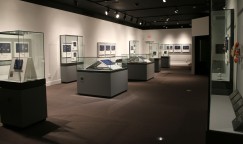 This unique exhibit features a collection of more than 200 distinctive pins and explores how Secretary of State Madeleine Albright—the first woman to serve in that office—used jewelry as a diplomatic tool. Organized by the Museum of Art and Design in New York City, the exhibit has been touring the nation for several years. There is no additional charge to see the exhibit at the Roosevelt Library.
This unique exhibit features a collection of more than 200 distinctive pins and explores how Secretary of State Madeleine Albright—the first woman to serve in that office—used jewelry as a diplomatic tool. Organized by the Museum of Art and Design in New York City, the exhibit has been touring the nation for several years. There is no additional charge to see the exhibit at the Roosevelt Library.
Madeleine Albright served under President Bill Clinton as U.S. ambassador to the United Nations from 1993-1997. In 1997, the President appointed her as Secretary of State. At that time she was the highest-ranking woman in the history of the U.S. government. During her years (1997-2001) as Secretary, Albright became known for wearing a wide variety of distinctive broaches that conveyed her views about the diplomatic or political situation at hand. Foreign officials began to pay special attention to Albright’s selection of pins to uncover clues about her state of mind. “I found that jewelry had become part of my personal diplomatic arsenal,” she later said. “While President George H.W. Bush had been known for saying ‘Read my lips,’ I began urging colleagues and reporters to ‘Read my pins.’”
A display of Eleanor Roosevelt pins will complement the exhibition during its time in Hyde Park. Read My Pins will remain on display through November 2, 2014. Secretary Albright will make a special public appearance at the Roosevelt Library on the evening of September 4 in connection with the exhibition.
The Roosevelt Library plans quite a trip for Summer 2014! Join us as we journey to seven continents and 95 countries for Around the World in 80 Days with the Roosevelts. Look for hundreds of internationally themed photographs, museum objects, and historic documents on the Library’s Tumblr — fdrlibrary.tumblr.com – and other social media accounts beginning Memorial Day weekend and culminating with the August 9th opening of our special exhibit, Read My Pins – the Madeleine Albright Collection.
80 consecutive days of special online features explore two lifetimes of travel and the Roosevelts’ common commitment to diplomacy and human rights. These posts draw on rich historical collections housed in both the Archives and Museum of the Franklin D. Roosevelt Presidential Library, and show the Roosevelts’ unique relationship with people and leaders across the globe. Learn how an American president worked directly with towering international figures, became the first to fly overseas while in office, and created the United Nations. Find out how Eleanor Roosevelt’s support of Allied troops in World War II and her advocacy for universal human rights inspired her famous moniker, First Lady of the World. We hope you’ll join us for this fascinating journey through the lives and work of two extraordinary global figures of the 20th century. Bon Voyage!
By Herman Eberhardt, Supervisory Museum Curator
The Roosevelt Library’s new 12,000 square foot $6 million permanent exhibition, which opened to the public in June 2013, features a variety of audiovisual experiences, including an array of interactive touchscreen programs. They help us tell the vital story of the Roosevelt era to new generations of Americans in fresh and engaging ways. These exhibits are just one part of a wider ongoing effort at the Library to harness new media technologies to reach new audiences.
Later this year, the Museum will unveil two new media initiatives that will greatly expand accessibility to our exhibits.
We are currently working with Audio Description Associates of Takoma Park, Maryland, on an Audio Description Tour of the new permanent exhibition for blind and vision-impaired visitors. The tour will be free to the public and available in both and English and Spanish language versions. Museum visitors will be able to download the audio tour to their own handheld devices or access it on one of the free hand-held media players that will be available for loan at the Henry A. Wallace Visitor and Education Center. The tour will also be accessible to online visitors on the Library’s web site.
Another exciting new media program in development is an online, interactive Virtual Tour of the permanent exhibition. Funded by a grant from the Newman’s Own Foundation, this tour will allow users from all over the world to experience our Museum and access additional educational materials. This project supports the Foundation’s goal of providing access to resources that contribute to the development of a civil society.
The virtual tour will employ high definition panoramic photography to give off-site users the experience of walking through the Museum. A zoom function will let users move around the galleries and select and learn more about specific artifacts, documents, photographs, and graphics. The Museum is working with the Dynology Corporation of Vienna, Virginia, on the development of the tour. Dynology is on the cutting edge of this new media tool. In recent years, a growing number of museums have begun to offer virtual tours. But most of these projects have involved art museums. History museums have been slower to embrace this new technology. Recently, Dynology broke new ground in the use of virtual tours in history museums with their innovative virtual tour of the United States Marine Corps Museum in Quantico, Virginia. Now they are working with us to expand on that model and create an even deeper and richer virtual experience.
Katherine Sardino, our multi-talented Museum Technician, is leading the Museum’s team on both of these innovative projects, which blend technology with history to advance the Library’s goal of presenting “A New Deal for a New Generation.” Keep watching our website and social media for updates on the rollout of these projects later this year.
by Jeff Urbin, Education Specialist
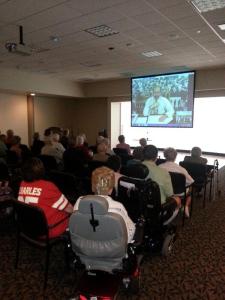 Franklin Roosevelt held the first of his famous “fireside chats” just days into his presidency thereby demonstrating his understanding of the importance of bringing accurate and unfiltered information directly from the source to the people. Today, with the help of quickly evolving technology, that tradition is being continued and expanded thru the Roosevelt Library’s Education Department’s distance learning program.
Franklin Roosevelt held the first of his famous “fireside chats” just days into his presidency thereby demonstrating his understanding of the importance of bringing accurate and unfiltered information directly from the source to the people. Today, with the help of quickly evolving technology, that tradition is being continued and expanded thru the Roosevelt Library’s Education Department’s distance learning program.
Whether you call it a virtual field trip, distance learning, or video conferencing, the ability to bring real-time, interactive learning and information into the classroom via technology is a modern educational miracle. Over the last three years the Roosevelt Presidential Library’s education department has provided dozens of distance learning sessions to thousands of students all across the United States, and as far away as Australia!
Classroom students are not the only learners who benefit from distance learning. The Roosevelt Library has been a pioneer in providing distance learning sessions to residents of adult and assisted living facilities. These folks are members of the Roosevelt demographic who, due to distance and/or mobility issues, are not able to visit the Library in person. Many of them have first-hand memories of Franklin and Eleanor Roosevelt from their childhood, or can remember their parents talking about them. The interactive nature of the video conference format allows residents to share their stories with the presenter which makes for a far richer session for everyone.
Advances in video conferencing technology have made it possible to bring information about the Roosevelts, the Great Depression and World War II to outside venues in an educational, interactive, and economical format. Just as FDR did with his Fireside Chats, we are bringing the information to the people; people of all ages and different situations. We think FDR would be amazed by the technology and very pleased with the results.
If you would like more information about distance learning programs, or would be interested in booking a session, contact me at jeffrey.urbin@nara.edu.
By Jeff Urbin, Education Specialist
 The learning begins as students enter the lobby of the Roosevelt Presidential Library and Museum welcomed by the friendly smile of our nation’s thirty-second president beaming down at them from a larger-than-life photograph. What lies beyond is a museum that brings to life the story of a twelve year presidency consisting of four national elections, the Great Depression, the Second World War; and the most remarkable First Lady of the 20th century. That’s a lot to cover in a single field trip.
The learning begins as students enter the lobby of the Roosevelt Presidential Library and Museum welcomed by the friendly smile of our nation’s thirty-second president beaming down at them from a larger-than-life photograph. What lies beyond is a museum that brings to life the story of a twelve year presidency consisting of four national elections, the Great Depression, the Second World War; and the most remarkable First Lady of the 20th century. That’s a lot to cover in a single field trip.
How can it possibly be done? That is a question that has both dogged, and delighted, me since becoming the Library’s education specialist nearly 13 years ago. The answer lies in breaking it all down and making sure that we address some fundamental elements that contribute to a meaningful educational experience. We begin with the intended audience in mind. Every decision that goes into planning and presenting our education programs is designed to meet the needs of the teachers and their students. Next we make sure that all of our programs are curriculum based, grade appropriate, and rich with primary source documentation. On the actual the day of the visit each group receives a program presented either by me, or one of my staff of four retired New York State Certified teachers.
Three additional overarching principles run through each of the programs: the first is that given the limited time that the students are on site; there is no way that we can tell anything even approaching the entire Roosevelt story. We can only hope to ‘plant the seeds of wonder’ in the students – to spark in them an interest in the presidency, public service, and the chances and challenges that history has presented us with. The second principle is to highlight certain ‘points of departure’ for further examination of the issues and topics we introduce. A key element in teaching students how to be critical thinkers is to challenge them with questions, not simply supply them with answers. A fieldtrip to the Roosevelt Presidential Library and Museum provides a wonderful point of departure from which students and teachers are invited and encouraged to explore the past in greater depth and detail. This can be done either in the classroom or on their own.
The final, and in many ways most important, principle is to make students aware that so much of what surrounds us in the world today can be traced back to the time of the Roosevelts. Some of these “current connections’-for example the Great Depression of the 1930s and the Great Recession of the last several years – are obvious. Others such as the push to expand electrification to rural areas then, and the push to expand WI-FI to some of these same areas today, are not.
By applying the simple recipes as described above, seasoned with a dash of fun, the Roosevelt Presidential Library’s education department fulfills the educational needs of more than 16,000 students, and 1000 teachers who visit our site each year. Look for my next blog when I will talk about our distance learning opportunities and web materials for those of you too far away to visit in person.


